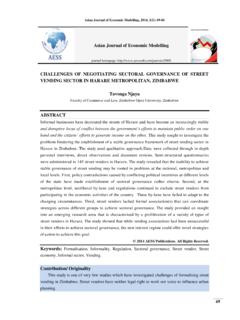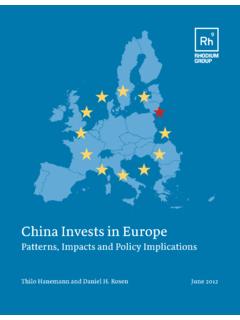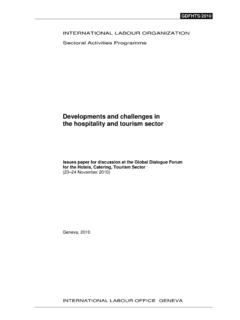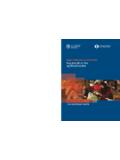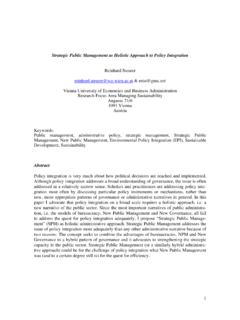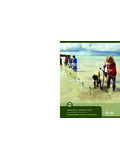Transcription of Rural Development and Poverty Reduction: Is …
1 Rural Development and Poverty reduction : Is Agriculture Still the Key? Gustavo Anr quez and Kostas Stamoulis ESA Working Paper No. 07-02. June 2007. Agricultural Development Economics Division The Food and Agriculture Organization of the United Nations ESA Working Paper No. 07-02. Rural Development and Poverty reduction : Is agriculture still the key? June 2007. Gustavo Anr quez Kostas Stamoulis Agricultural Development Agricultural Development Economics Division Economics Division Food and Agriculture Organization Food and Agriculture Organization Italy Italy e-mail: e-mail: Abstract This paper examines the relationship between rurality and Poverty , and the role the agricultural sector can play in Rural Development , Poverty reduction , and overall Development . The historical views regarding the role of the primary sector in Development are presented, and then using original data, the paper argues that there was an historical misjudgment against the primary sector that served as a foundation for anti-agricultural bias in public policy until the late 80's.
2 Finally, this paper explains how under certain conditions territorial/regional Development strategies may prosper, but in other conditions, particularly in the least-developed countries Rural space, agriculture is still necessarily the starting point for Rural Development . Key Words: Rural Development , agricultural growth, Poverty reduction , production linkages. JEL: Q10, O10, O13. The designations employed and the presentation of material in this information product do not imply the expression of any opinion whatsoever of the part of the Food and Agriculture Organization of the United Nations concerning the legal status of any country, territory, city or area or of its authorities, or concerning the delimitation of its frontiers or boundaries. Introduction It is not an exaggeration to say that the battle to achieve the global society's stated objectives on hunger and Poverty reduction will be won or lost in the Rural areas of the developing countries.
3 Globally, extreme Poverty continues to be a Rural phenomenon despite increasing urbanization. Of the world's billion extremely poor people, 75 percent live in Rural areas and for the most part they depend on agriculture, forestry, fisheries and related activities for survival. The promotion of the Rural economy in a sustainable way has the potential of increasing employment opportunities in Rural areas, reducing regional income disparities, stemming pre-mature Rural -urban migration, and ultimately reducing Poverty at its very source. In addition, Development of Rural areas may contribute to the preservation of the Rural landscape, the protection of indigenous cultures and traditions while Rural societies could serve as a social buffer for the urban poor in periods of economic crisis or social urban unrest.
4 However, public policies at national level and resource mobilization at both national and international levels have not always recognized the multiple potential of the Rural economy. Public policies and investments in developing countries have historically favored industrial, urban and service sectors at the expense of agricultural and other Rural sector Development . In many cases, a coherent Rural Development policy (by its very nature cross- cutting) has fallen victim of the lack of a cross-sectoral institutional framework. The past 20 years have witnessed a steep decline in the availability of public resources for agriculture and Rural Development . Between 1983-1987 and 1998-2000, the annual average allocations of Official Development Assistance (ODA) for agriculture in the least- developed and other low-income countries fell by 57 percent from USD billion (2002.)
5 Prices) to USD billion. Lending from international financial institutions followed a similar pattern while domestic public spending has remained stagnant at best. The result has been reduced incentives for Rural investment. Serious questions have also been raised as to the efficiency and effectiveness of public resource mobilization for agriculture and the Rural space. For example, L pez and Galinato (2007) show a consistent bias in Rural spending in Latin America in favor of subsidies and against investment in public goods which has translated into lower agricultural growth in the region. An important question in the Development debate regarding Rural Development has been the relationship between agriculture and the Rural economy. In certain respects, past policy perceptions and practice have often equated Rural Development with agriculture, and Rural Development policies have been subsumed under an agricultural policy package.
6 The issue of how and under what conditions agriculture is a driving force of Rural growth has received scant attention or has given mixed messages including in the position of major multilateral financing institutions 1. Recently however, the emergence of national and international commitments on Poverty and related targets (as for instance in the Millennium Development Goals and the Poverty reduction Strategies at country level) coupled with the failure of past paradigms to make mass reductions in Rural Poverty , have given a new impetus to the role of agriculture in Development and Poverty reduction . While at the same time, new Rural Development models have emerged (especially in the context of Latin America) emphasizing a more broad approach in which Rural and urban space are viewed as a continuum and their interactions are emphasized (de Janvry and Sadoulet (2007).)
7 The principal objective of this paper is to present in a concise way, some of the conceptual issues regarding the role of agriculture in both Rural and overall Development , emphasizing its role in Poverty reduction ; and to explore if agricultural Development can be an engine of growth and Poverty reduction in developing countries, and under what conditions. The paper is structured as follows: In the next section we deal with issues of definition of rurality and Rural Development . Next, we explore the link between Poverty and rurality. Then we discuss the role of agriculture in Development , Rural Development and Poverty reduction . We then discuss contexts in which spatial constraints make a sectoral (agricultural). Development entry point necessary. Finally some concluding remarks are provided.
8 Definitions What is Rural Development The definition of Rural Development has evolved through time as a result of changes in the perceived mechanisms and / or goals of Development . A reasonable definition of Rural Development would be: Development that benefits Rural populations; where Development is understood as the sustained improvement of the population's standards of living or welfare. This definition of Rural Development , however, has to be further qualified. In the 1960's and early 1970's the consensus was that intense industrialization was the main characteristic of the perceived Development path. In this context it seemed natural to define Rural Development as precisely leading into that path: Rural Development is essentially 1. Compare for instance the World Bank's Rural Development strategy in the Vision to Action document (World Bank (1997)) which is heavily oriented towards agriculture to the latest strategy, reaching the Rural poor (World Bank (2003)) in which the role of agriculture is substantially less prominent.
9 2. a part of structural transformation characterized by diversification of the economy away from agriculture. This process is facilitated by rapid agricultural growth, at least initially, but leads ultimately to a significant decline in the share of agriculture to total employment and output and in the proportion of Rural population to total population. (Johnston, 1970) . Later during the 70's, mostly based on equity considerations, the focus and definition of Rural Development turned to the provision of social services to the Rural poor. This shift was partially founded on the recognition that even under rapid growth of income in Rural areas, the availability or equitable access to social services and amenities was not guaranteed2. Lacroix (1985) exemplifies this line of thought when he explains the difference between agricultural and Rural Development : Agricultural Development generally tries to raise agricultural production and productivity and is of a technical nature.
10 It is similar to other efforts to develop physical capital as a means for economic growth Rural Development , though, by definition is oriented more toward benefiting primarily the poor Thus, the fundamental distinction between pure agricultural and Rural Development is the emphasis on capital Development for the former, and human capital Development for the latter.. Since the 1970's Rural Development as a concept has been highly associated with the promotion of standards of living and as a precondition for reducing Rural Poverty . This pro- poor bias was born from the understanding that, particularly in societies where wealth is extremely concentrated, mean incomes could grow without improving the well being of the most dispossessed. Thus, if the general definition of Rural Development is accepted, the improvement of the welfare of all members of the Rural populations, then this pro-poor bias is justified.










